Dear Aspirants, IBPS Clerk 2018 Preliminary Examination is scheduled to be held on 8th, 9th, 15th and 16th of December. Candidates who have a dream to crack the IBPS Clerk 2018 need to speed up the preparation from now.
Our IBPS Guide team is providing a full-length Sectional Tests for English Language, Reasoning Ability and Numerical Ability with precise solutions for assisting you to crack IBPS Clerk Prelims exam.
Take Free Reasoning Ability Sectional Test of 35 Questions as like in the real exam to analyze your preparation level. Our Sectional Test Questions are taken as per the latest exam pattern and so it will be really useful for you to crack the prelims exam lucratively. Students who are weak in Reasoning Ability should utilize this chance constructively to accomplish a successful profession in Banking Field.
[WpProQuiz 4078 ]
Click Here for IBPS Clerk Prelims 2018 High-Quality Mocks
Directions (1-5): Study the following information carefully and answer the questions given below:
There are ten person Q, R, S, T, U, V, W, X, Y, and Z sitting around a circular table. All of them are facing center. Person name starts with consecutive alphabet does not sit adjacent to each other.
U sits three persons away from Z. R and T are sitting adjacent to each other. W is an immediate neighbour of U. Y is not an immediate neighbor of U. S sits second to the right of W. Only two persons sit between V and Y. R is not an immediate neighbour of V. Q sits an immediate right of S and sits opposite to R. T is not an immediate neighbour of Z.
1) Who among the following persons sits third to the right of W?
a) U
b) Z
c) X
d) Q
e) None of those given as the option
2) Who among the following person sits opposite to Z?
a) S
b) W
c) Y
d) T
e) Cannot be determined
3) What is the position of T with respect to W?
a) Third to the right
b) Third to the left
c) Second to the right
d) Second to the left
e) None of those given as the option
4) How many persons sit between W and X?
a) None
b) 2
c) 3
d) 4
e) More than 4
5) Who among the following pair sits an immediate neighbour of X?
a) Y, Q
b) Z, T
c) Z, Q
d) Y, T
e) None of those given as option
Directions (6-10): Study the following information carefully and answer the questions given below:
A, B, C, D, E, F, and G are sitting in a straight line. Some of them are facing south and some of them are facing north. More than two persons are facing the same direction are not sit together. All the information is not necessarily in the same order.
F sits third from the extreme end. Immediate neighbours of C are facing the opposite direction. Only two persons sit between D and E. C sits an immediate right of A. Neither D nor E sits at the extreme ends. Immediate neighbours of G are facing the same direction. F sits third to the left of C and both of them are facing the same direction. B sits an immediate right of D. F and B are facing the opposite direction. G is not facing south. E is not an immediate neighbour of F.
6) Who among the following persons sit at the extreme ends?
a) C, B
b) E, A
c) A, B
d) C, B
e) None of those given as the option
7) Who among the following person sits immediate right ofE?
a) C
b) D
c) E
d) A
e) Cannot determined
8) What is the position of C with respect to G?
a) Third to the right
b) Third to the left
c) Second to the right
d) Second to the left
e) None of those given as the option
9) How many persons sit between F and D?
a) None
b) 2
c) 3
d) 4
e) More than 4
10) Who among the following person is an immediate neighbor of B?
a) A
b) B
c) C
d) D
e) None of those given as the option
Direction (11-14): Read all the statements and then decides which of the given conclusions logically follows from the given statements disregarding commonly known facts.
a) Either conclusion I or conclusion II follows
b) Only conclusion I follow
c) Both conclusion I and conclusion II follows
d) Only conclusion II follows
e) Neither conclusion I nor conclusion II follows
11) Statements
Some Books are Pens
Some Pens are Paper
All Papers are White
Conclusion
Some Whites are Pen
Some Book are White is a Possibility
12) Statements
All Balls are Bat
Some Bats are Pad
No Pad is Stick
Conclusion
Some Pads are Ball
Some Bats are not Stick
13) Statements
Some Apples are Orange
No Orange is Papaya
All Papaya is Pineapple
Conclusion
Some Apples are Papaya
Some Oranges are not Pine apple
14) Statements
All Buses are Trains
Some Trains are Car
All Cars are Lorry
Conclusion
Some Lorries are Train
Some Buses are Car
Directions (15-17): Study the following information carefully and answer the questions given below:
A, B, C, D, E, F, G, and H, are belongs to the same family but from three different generations. There is an equal number of males and females in the family.
E is the grandfather of C. B and G are the only children of H. A is brother in law of B. F is the niece of G. D is the sister in law of G. C is the son of A.
15) How is H related with respect to G?
a) Father
b) Mother
c) Grandmother
d) Grandfather
e) None of those given as the option
16) What is the relation of F with respect to H?
a) Son
b) Daughter
c) Grand son
d) Grand daughter
e) None of those given as the option
17) How is A related with respect to E?
a) Father in law
b) Mother in law
c) Daughter in law
d) Son in law
e) None of those given as the option
Directions (18-19): Study the following information carefully and answer the questions given below:
A man starts walking from his home towards east direction. After walking 4km he took left turn and walks 5km. Then he took right turn and walks 6km. Again he took right turn and walk 8km. Finally, he took right turn to reach the ground after walking 10km.
18) What is the shortest distance between the home and the ground?
a) 3km
b) 4km
c) 5km
d) 6km
e) None of those given as option
19) In which of the following direction is the home with respect to the ground?
a) South
b) East
c) West
d) North
e) None of those given as option
20) How many such pairs of letters are there in the word “DOMESTIC” each of which has as many letters between them in word as they have in English alphabet?
a) One
b) Two
c) Three
d) More than three
d) None
Directions (21-25): Study the following information carefully and answer the questions given below:
Arun, Vijay, Ram, Babu, and Shanhave attended the exam on different the days of the week starting from Monday to Friday. Theybelong to different cities i.e. Delhi, Mumbai, Chennai, Hyderabad, and Kolkata but not necessarily in the same order.
Arun belongs to Mumbai but does not have an exam on Tuesday. The one who belongs to Delhi attends the exam immediately before the one who belongs to Chennai. Babu attends the exam on Thursday. Shan attends the exam immediately after the one who belongs to Hyderabad. Shan attends the exam neither Tuesday nor Wednesday. Arun does not have an exam on Wednesday.
21) Arun has exam on which one of the following days?
a) Monday
b) Tuesday
c) Wednesday
d) Thursday
e) None of those given as option
22) Who among the following person belongs to kolkata?
a) Arun
b) Vijay
c) Ram
d) Shan
e) None of those given as option
23) Who among the following person attends the exam on Wednesday?
a) Arun
b) Vijay
c) Ram
d) Babu
e) Cannot be determined
24) How many persons have attended the exam betweenBabu and Arun?
a) None
b) 1
c) 2
d) 3
e) 4
25) Which of the following combination is incorrect?
a) Monday – Arun – Mumbai
b) Tuesday – Ram – Delhi
c) Thursday – Babu – Hyderabad
d) Friday – Shan – Kolkata
e) None of those given as option
Directions (26-30): Study the following information carefully and answer the questions given below.
Eight persons J, K, L, M, N, O, P, and Q are living on different floors of a nine-story building and one of the floors is vacant. The ground floor is numbered as 1 and the above floor is numbered as 2 and so on till the topmost floor is numbered as 9.
The vacant floor is an odd numbered floor but not on the bottommost floor. Only two persons live between M and O and both of them lives an odd numbered floor. O does not live any of the floor below M. K lives immediately above O. Only two persons live between L and N. J lives immediately above N.M lives immediately below P.
26) Who among the following person lives on the topmost floor?
a) J
b) N
c) K
d) Q
e) None of those given as option
27) P lives on which one of the following floors?
a) First
b) Second
c) Third
d) Fourth
e) None of those given as option
28) Who among the following person lives on immediately below Q?
a) K
b) L
c) O
d) J
e) None of those given as option
29) How many persons live between P and N?
a) None
b) 1
c) 2
d) 3
e) 4
30) Four among the five are alike in such a way based on their certain arrangement, find the one who does not belongs to the group?
a) P
b) L
c) N
d) K
e) J
Directions (31-33): Study the following information carefully and answer the questions given below.
![]()
31) How many numbers are there in the arrangement which is immediately followed and preceded by a consonant?
a) None
b) One
c) Two
d) Three
e) None of those given as option
32) Which of the following element is seventh to the left of the element which is fifth from the right end?
a) 9
b) @
c) =
d) +
e) None of those given as option
33) If all the symbols are dropped in the arrangement then which of the following element is fourteenth from the left end?
a) <
b) J
c) K
d) L
e) None of those given as option
34) The position of how many alphabets will remain unchanged if each of the alphabets in the word “OBSOLESCENT” is arranged in alphabetical order from right to left?
a) None
b) One
c) Two
d) Three
e) None of those given as option
35) Which of the following symbol replaces question mark to make F < O is definitely True?
H≥ F ? L≤ N = A ? O
a) >, <
b) <, ≤
c) >, ≥
d) <, >
e) None of those given as option
Answers:
Direction (1-5):

Note: Person name starts with consecutive alphabet does not sit adjacent to each other, It means R is not an immediate neighbor of neither Q nor S, Similarly, S is not an immediate neighbor of neither R nor T and so on..,
- U sits three persons away from Z.

- Q sits an immediate right of S and sits opposite to R.
- W is an immediate neighbor of U.
- S sits second to the right of W.

Incase 1a,Q sits an immediate right of S and sits opposite to R, this condition is not satisfied so this case is eliminated.
- R and T are sitting adjacent to each other.
- Y is not an immediate neighbor of U.
- Only two persons sit between V and Y.
- R is not an immediate neighbor of V.
- T is not an immediate neighbor of Z.

Incase 1b,T is not an immediate neighbor of Z, this condition is not satisfied so this case is eliminated.
1) Answer: D
2) Answer: C
3) Answer: B
4) Answer: D
5) Answer: E
Direction (6-10):

- F sits third from the extreme end.
- Only two persons sit between D and E.
- F sits third to the left of C and both of them are facing the same direction.
- E is not an immediate neighbor of F.
- Neither D nor E sits at the extreme ends.
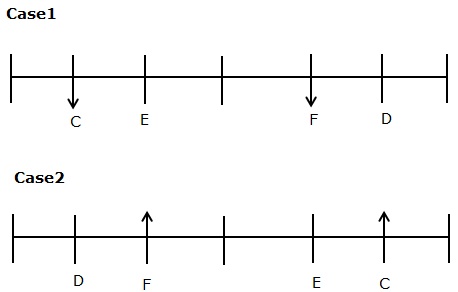
- Immediate neighbors of C are facing opposite direction.
- C sits an immediate right of A.
- Immediate neighbors of G are facing the same direction.
- G is not facing south.

Incase 2, G is not facing south, this condition is not satisfied so this case is eliminated.
B sits an immediate right of D. F and B are facing the opposite direction.

6) Answer: C
7) Answer: A
8) Answer: D
9) Answer: A
10) Answer: D
11) Answer: C

12) Answer: D

13) Answer: E

14) Answer: B
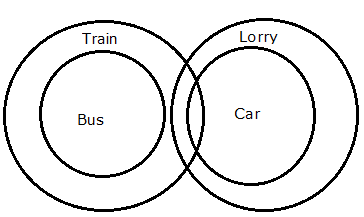
Directions (15-17):

15) Answer: B
16) Answer: D
17) Answer: D
Directions (18-19):

18) Answer: A
19) Answer: D
20) Answer: B

Directions (21-25):
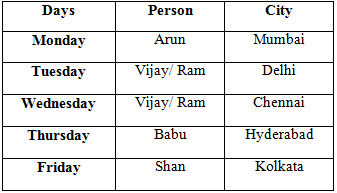
- Arun belongs to Mumbai but does not have an exam on Tuesday.
- Babu attends the exam on Thursday.
- Sham attends the exam immediately after the one who belongs to Hyderabad.
- Shan attends the exam neither Tuesday nor Wednesday.
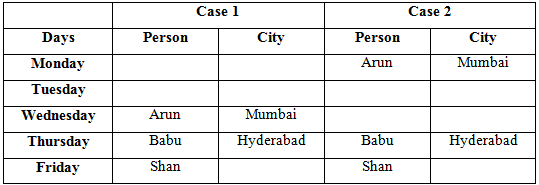
- The one who belongs to Delhi attends the exam immediately before the one who belongs to Chennai. Arun does not have an exam on Wednesday.
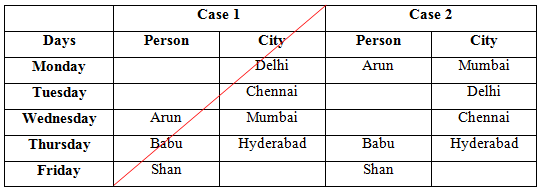
In Case 1, Arun does not have an exam on Wednesday, this conditionis not satisfied, so this case is eliminated.

21) Answer: A
22) Answer: D
23) Answer: E
24) Answer: C
25) Answer: B
Directions (26-30):
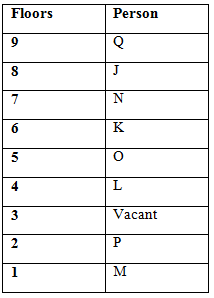
- The vacant floor is an odd numbered floor but not on the bottommost floor.
- Only two persons live between M and O and both of them lives an odd numbered floor.
- O does not live any of the floors below M.
- K lives immediately above O.
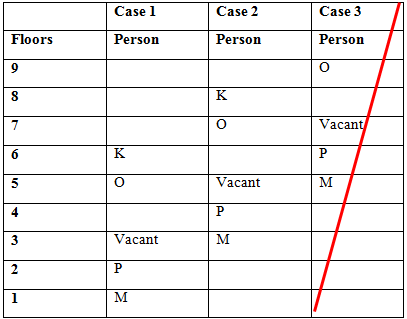
Incase 3, K lives immediately above O, this condition is not satisfied so this case is eliminated.
- Only two persons live between L and N.
- J lives immediately above N.
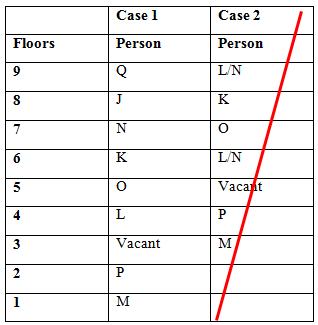
Incase 2, J lives immediately aboveN, this condition is not satisfied so this case is eliminated.
26) Answer: D
27) Answer: B
28) Answer: D
29) Answer: D
30) Answer: C
31) Answer: B
A B C 4 5 @ $ ? S T R 7 8 9 + = < J K L 2 N 3 > G H I
There are one such number is there in the arrangement which is immediately followed and preceded by a consonant
32) Answer: C
“=” is seventh to the left of the element which is fifth from the right end in the arrangement.
33) Answer: D
If all the symbols are dropped in the arrangement, then “L” is the element which is fourteenth from the left end.
34) Answer: D

35) Answer: B
![]()





